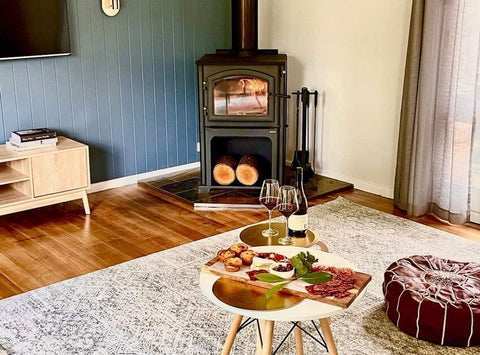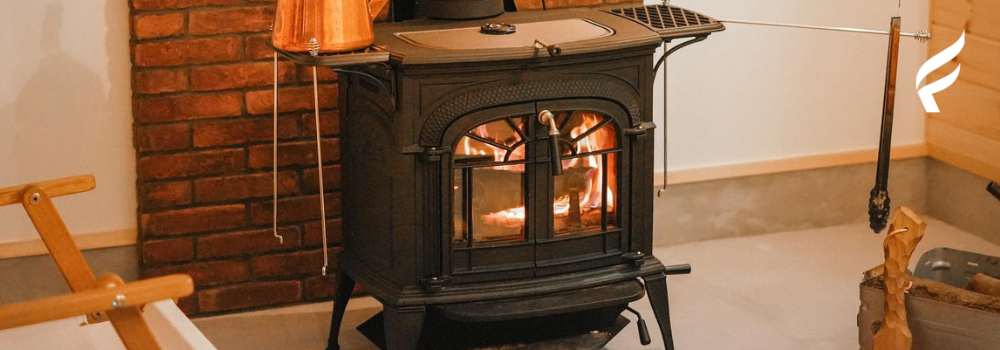Starting a fire is easy, right? You set a match to your firewood, wait for it to catch and voila; you have a fire. Sure, it can be that easy, but there are several variables to consider if you’re looking to maximize your wood fire experience. Read on as we explore the best practices for starting a fire in a wood stove. By the end of this article, you’ll be an expert on how to start a fire!
Materials for Starting a Fire
When you’re ready to start your fire in your wood-burning stove, it’s important to gather all of the necessary materials to be sure that your fire starts easily, grows to the desired size and burns long and efficiently. There are a few essentials that you’ll need to ensure success:
- Extra-long fireplace matches
- Kindling that’s 1" to 2" diameter and made from dry, seasoned wood
- Newspaper or another easy-to-ignite material for a firestarter
- The best firewood you can find
Some of these materials have alternatives. For instance, a barbecue lighter can substitute extra-long fireplace matches. Newspaper may not always be available, but cardboard ripped into thin pieces, biodegradable egg cartons (no styrofoam), or even dryer lint make fine stand-ins. You may even be able to find a wood stove fire starter tailor-made to start a stove fire. Your local hardware store should have what you need available for purchase. Before you start be sure to inspect your stove and chimney to confirm that the equipment is in good repair and safe for wood burning.
Preparing Fuel

Now that you’ve gathered the appropriate materials to light a fire, let’s take a look at your firewood, also known as “fuel.” Knowing how to use a wood-burning stove effectively means knowing how to start a fire and how to keep a fire going. Hands down the most important factor in managing the second point is your fuel–not only the species of wood, but the state of it as well.
In order to achieve the longest burn time when you light a fire you’ll need to use properly seasoned firewood, meaning that it’s been left to condition in a dry environment until the moisture content of the wood is 18-20%. This step is important because wood that’s too wet will not produce a vigorous flame and is more likely to emit plumes of smoke which could result in unwanted creosote buildup and black glass.
Hardwoods, such as oak, cherry and sugar maple, are ideal for firewood due to their respectable heat output and density, which relates to the efficiency and duration of the burn. Many consider hardwoods the best firewood to burn. But don’t throw out any softwoods that you might have lying around. Softwoods such as pine or cedar make great kindling to start your fire with because they catch fire easily and produce a lively flame that creates a solid foundation for your fire.
3 Steps to Build a Fire in a Wood Stove
Now that you know how to gather the right materials, select suitable fuel, and check your equipment for safety. Let’s take a step-by-step look at fire starting so that you can heat your home with wood.
Step 1: Prepare the Stove and Kindling
Set your damper to the closed or low position. Kindling should be 1" to 2" in diameter and made from wood that’s been seasoned to a moisture content of 18-20%. Place the kindling along with your chosen firestarter in the firebox to serve as the base of your fire. Introduce your flame source to the firestarter until it catches fire. Keep an eye on the fire to ensure that your firestarter doesn’t burn out before the kindling has started to hold a flame.
Pro Tip: You may want to learn how to make a fire starter from materials around your house. The best DIY firestarters are made from dry, flammable materials such as dryer lint, cardboard, paper or sawdust.
Step 2: Build and Spread
Your kindling should burn down, at which point you can add smaller pieces of fuel to the firebox on top of the coals created by the kindling. As the smaller wood catches and maintains healthy flames, you can add larger pieces of firewood. Knock this flaming fuel down with a poker or other fire tool to create a hot bed of coals, taking care not to damage the brick liner in your stove.
Step 3: Add Fuel
When you have a layer of red-hot coals, you’re ready to add your seasoned firewood. The best way to build a fire is to stack your logs in a crosshatch pattern in order to facilitate the flow of air between each piece as it burns and falls.
Do not overfill your firebox. Maintaining 6" to 8" of space between the topmost log and the top of your firebox will maintain enough space for your fire to burn. Adjusting your intake and damper will allow you to control the heat output and duration of your burn. Remember, the more air your fire has, the faster and hotter it will burn.
Key Considerations
- More wood isn’t always better. Adding wood before the fuel already in the stove has burned down can smother the fire.
- Take care when adding wood to a burning fire. Slowly open the door to the firebox to avoid pulling ash, smoke or embers into your space.
- Carefully add the new wood with heavy-duty fire tongs or fireproof gloves that reach at least to your elbow.
- Only open the door to add wood to the fire or to clean the firebox when there is no fire in the stove. Once you are finished adding fuel, secure the door and enjoy the fire.
- You should not allow a fire to burn unattended overnight. A fire should always be cared for to avoid a smoldering fire that can lead to unsightly creosote buildup.
- A clean stove is a happy (and safe) stove. Be sure to remove accumulated ashes weekly. Also, inspect your firebricks, stove door, gasket and handle and ensure that your chimney remains free of obstruction.
How Forge & Flame Wood Stove Technology Simplifies Heating

Now that you know how to use a wood stove, let’s discuss which stove is right for you. We offer an impressive range of wood stoves and fireplace inserts and a network of professional installers who are eager to help.
Vermont Castings stoves boast a list of features that make heating your home with natural fire easy and effective. Continuous Combustion Control (C3) Technology ensures that your stove is optimally adjusted to produce a fire that is consistent and efficient. FlexBurn technology maximizes the burn so that you’re always getting the most out of your firewood thanks to 2-stage and 3-stage burn capabilities that capture emissions and convert them into heat for your home. All of these features are controlled with a built-in thermostat that does not require electricity.
Quadra-Fire stoves are elegant and offer reliable heating performance enabled by cutting-edge technology. Automatic Combustion Control (ACC) is a tool that precisely controls airflow to your fire, resulting in steady, long-lasting burns. The patented Four-Point Burn System creates four combustion cycles that produce exactly the heat that you want when you want it. This technology will elevate your fire experience while saving you money.
Q&A/Troubleshooting
Whether you’re new to fire starting, or you’re an old hand, sometimes things don’t go as you’d like. Being a skilled wood burner takes preparation, patience and practice. What do you do when you can’t start a fire? Let’s examine a few common issues that you may run into when learning how to start a fire in a log burner.
Why won’t a fire start in my wood stove?
Check to make sure that your firebox has plenty of firestarter and kindling and that the kindling is dry. Ensure that your air intake is open so that some air is moving through the space.
Why is my firewood not catching fire?
If your firewood is failing to take up flame, it’s most likely because the wood is not dry enough. Only use firewood that’s been seasoned for the right amount of time and kept away from moisture.
Why is my stove smoking a lot?
A fire that is smoking excessively could be caused by the wood not being ready to be used as fuel. If your wood has a moisture level above 20%, you may experience more smoke than normal. Some species of wood produce more smoke than others, so this factor should also be considered when selecting your fuel.
How do I reduce creosote?
Nobody likes black glass in their elegant wood stove. Creosote is a byproduct of smoke residue accumulating on the inner surfaces of your stove. Ensuring that you are using properly seasoned fuel, avoiding smoldering fires and that your chimney is free of anything that might restrict airflow will all help minimize creosote buildup. Read more about creosote and how to minimize it here.


